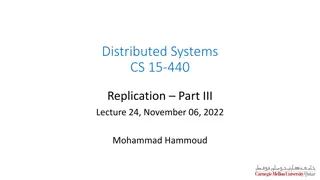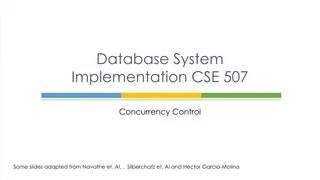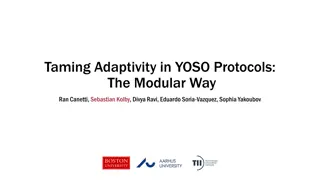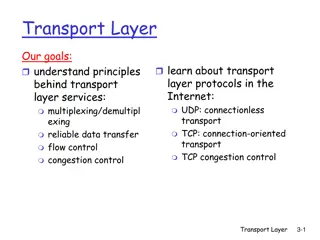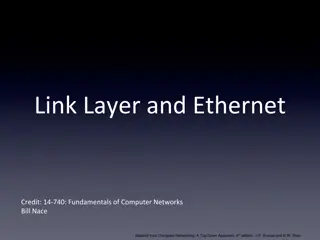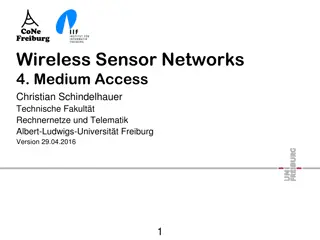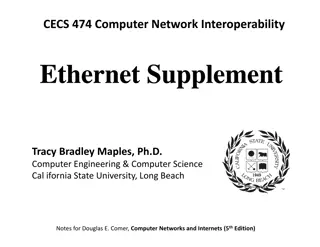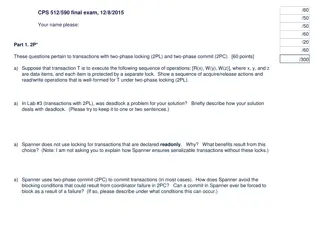
Data Link Control Protocols in Computer Networks
Explore High-Level Data Link Control (HLDC) and HDLC protocols in computer networks, including frame types, frame formats, and their functions. Learn about the role of frames in transmitting information and managing network links efficiently.
Download Presentation

Please find below an Image/Link to download the presentation.
The content on the website is provided AS IS for your information and personal use only. It may not be sold, licensed, or shared on other websites without obtaining consent from the author. If you encounter any issues during the download, it is possible that the publisher has removed the file from their server.
You are allowed to download the files provided on this website for personal or commercial use, subject to the condition that they are used lawfully. All files are the property of their respective owners.
The content on the website is provided AS IS for your information and personal use only. It may not be sold, licensed, or shared on other websites without obtaining consent from the author.
E N D
Presentation Transcript
6 Computer Networks Chapter Seven DATA LINK LAYER Data Link Control and Protocols (Part IIIa) Asst. Prof. Dr. Mazin S. Al-Hakeem
High-Level Data Link Control HLDC General Protocol Point-to-Point Access Protocol (PPP) : Dedicated Link Multiple-Access Protocol : Common Link (Broadcast Link)
7.8- HDLC (High-Level Data Link Control) It is a bit-oriented protocol (general protocol) for communication over point-to-point and multipointlinks. It implements the ARQ mechanisms. Link Dedicated Link Point-to-Point Access Protocol (PPP) Common Link Multiple-Access Protocol
7.9- Frames To provide the flexibility necessary to support all the options possible in the modes and configurations just described, HDLC defines three types of frames: Information Frames (I-frames) used to transport user data and control information relating to user data, Supervisory Frames (S-frames) used only to transport control information, Unnumbered Frames (U-frames) used to transport Information that intended for managing the link itself. reserved for system management.
7.9- Frames (HDLC frames types) Each type of frame serves as an envelope for the transmission of a different type of message. Frame Format
Frame Format Each type of frame serves as an envelope for the transmission of a different type of message. Flag Flag Flag field: The flag field of an HDLC frame is an 8-bit sequence with the bit pattern 01111110 that identifies both the beginning and the end of a frame and serves as a synchronization pattern for the receiver.
Frame Format Each type of frame serves as an envelope for the transmission of a different type of message. Flag Address Flag Address field: The second field of an HDLC frame contains the address of the secondary station. If a primary station created the frame, it contains a to address. If a secondary creates the frame, it contains a from address. An address field can be 1 byte or several bytes long, depending on the network size.
Frame Format Each type of frame serves as an envelope for the transmission of a different type of message. Flag Address Control Flag Control field: The control field is a 1- or 2-byte segment of the frame used for flow and error control. The interpretation of bits in this field depends on the frame type.
Frame Format Each type of frame serves as an envelope for the transmission of a different type of message. Flag Address Control Information Flag Information field: The information field contains the user's information (I-Frame) from the network layer or management information (U-frame)
Frame Format Each type of frame serves as an envelope for the transmission of a different type of message. Flag Address Control Information FCS Flag FCS field: The frame check sequence (FCS) is the HDLC error detection field. It can contain either a 2- or 4-byte ITU-T CRC.
HDLC (High-Level Data Link Control) Link Dedicated Link Point-to-Point Access Protocol (PPP) Common Link Multiple-Access Protocol User I-frames Flag Address Control FCS Flag Information S-frames Flag Address Control FCS Flag Management Information U-frames Flag Address Control FCS Flag
Computer Networks Chapter Seven DATA LINK LAYER Data Link Control and Protocols (Part III a) Asst. Prof. Dr. Mazin S. Al-Hakeem



